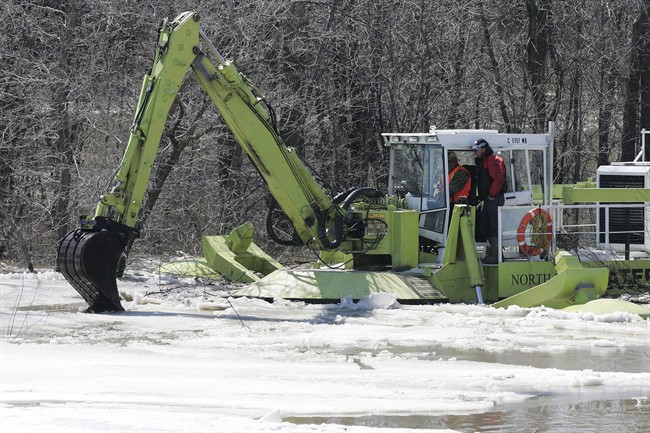SELKIRK, Man. – Long before many Manitobans dared to hope that spring would end their brutally cold winter, 28 hearty people donned floatation suits and made their way onto the Red River north of Winnipeg.

The crew is on the front lines of the province’s annual battle against spring flooding.
The weapons? A bizarre-looking half-back-hoe, half-barge called an Amphibex machine and a made-in-Manitoba remote control Bobcat saw.
The tools are at the heart of a sophisticated, round-the-clock operation that breaks up 30 kilometres of ice down the centre of the Red River before the thaw, reducing the possibility that big chunks will dam the river and cause a sudden flood.
“You think you’ve seen it all but you haven’t,” said Darrell Kupchik, executive director of operations of North Red Waterway Maintenance, which oversees the ice-breaking operation. “We’re constantly learning, constantly adapting.”
Manitoba bought its first Amphibex in 2006.
The buoyant machine, which was actually built for summer dredging, helps break up ice by hoisting its 20,000-kilogram body up onto the ice surface using an excavator-like claw. The sheer weight of the machine crushes the ice below.
It can move at a rate of about one kilometre a day, but Kupchik said crew members quickly realized they could break up more ice if the surface was weakened first.
Unable to find equipment that could do the job, they set about making an ice-cutter by essentially strapping a saw blade to a tractor. By the end of the operation, however, the poor driver was windburned and there were some obvious safety concerns, Kupchik said.
- Life in the forest: How Stanley Park’s longest resident survived a changing landscape
- ‘Love at first sight’: Snow leopard at Toronto Zoo pregnant for 1st time
- Carbon rebate labelling in bank deposits fuelling confusion, minister says
- Buzz kill? Gen Z less interested in coffee than older Canadians, survey shows
Several prototypes later and the crew came up with a modified remote-controlled Bobcat to do the cutting.
When one of those sank through the ice, custom “water wings” for the machines — essentially pontoons — were devised.
Manitoba now operates four Amphibex machines and four specially rigged Bobcats.
The ingenuity has attracted international attention and visits by delegations from the United States and Brazil.
“This isn’t happening anywhere in the world,” Kupchik said.
The job of running the machines isn’t for everybody.
The ideal candidate is someone with some coast guard experience, but also with a construction background to operate heavy machinery. “Outdoor people” are encouraged to apply.
Brian Sparks has been with the operation since its beginning nine years ago.
What the 60-year-old knows about ice could fill a book, he jokes.
Looking back at the trail of broken ice down the middle of the Red River, Sparks said it’s a bit like “tilling your garden.”
The big difference is that when something goes wrong, it’s up to the Amphibex operator to climb out in -40 C temperatures and fix it.
“They don’t have a tow truck for us,” Sparks said. “You’d think it would be really monotonous. But the way ice breaks every time you go, it takes the monotony out of it, because you can’t just do the same thing over and over. You’ve got to change up all your moves.
“It’s not the quickest ride down the river, but it’s like the turtle — it never stops.”
The equipment cost $6.5 million. It costs another $1.6 million each year to run the operation around the clock.
Steve Ashton, Manitoba’s emergency measures minister, said the investment is worth it.
“Our experience has been for every dollar you invest in something of this nature, it saves you significant dollars down the line in terms of damage,” he said. “More importantly, it limits the flooding that is pretty traumatic for people in the area.”



Comments